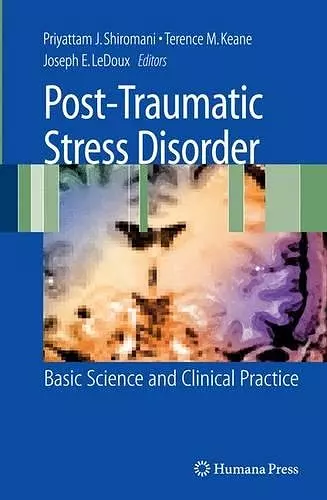Post-Traumatic Stress Disorder
Basic Science and Clinical Practice
Joseph E LeDoux editor Peter Shiromani editor Terrence Keane editor
Format:Paperback
Publisher:Humana Press Inc.
Published:4th Dec '14
Currently unavailable, and unfortunately no date known when it will be back

Post-traumatic stress disorder is a psychiatric illness that can occur in anyone who has experienced a life-threatening or violent event. The trauma can be due to war, terrorism, torture, natural disasters, violence, or rape. In PTSD the brain areas that are likely to be affected are the hippocampus (memory), amygdala (fear association), the prefrontal cortex (cognitive processing), and the ascending reticular activating system (arousal). The chemical of interest is norepinephrine, which is released during a stressful event and is part of the fight-or-flight response meant to mobilize the body to action.The objective of this title is to outline the neurobiology of post-traumatic stress disorder and provide treatment strategies for clinicians. The chapter material from this book has evolved from a seminar on PTSD held recently under the auspices of the VA Boston Healthcare System, Boston University Medical Center and Harvard Medical School. We propose a book that will focus on the epidemiology, neurobiology, MRI studies, animal models, arousal and sleep issues, clinical trials, and treatment strategies for clinicians. Treatment will cover such topics as guidelines for treating posttraumatic stress disorder, PTSD and the use of mental health services, cognitive intervention therapy, and large scale clinical trials in PTSD. This collection will be a vital source of information to clinicians and neuroscientists.
From the reviews:
"This book uses a variety of authors to review various aspects of the diagnosis, physiology, neurobiology, evaluation, and treatment of PTSD. … an invaluable resource for all clinicians and neuroscientists concerned with the condition. … Chapters end with an extensive list of current and relevant references, and numerous illustrations, diagrams, and figures … highlight salient features of the discussions. … It is well written, and the diagrams and illustrations provide appropriate visual representations of the important major points." (Steven T. Herron, Doody’s Review Service, September, 2009)
“Peter Shiromani … produce a book that will have much to offer both clinicians and investigators in the field of sleep. … provide a clear and comprehensive overview of the mechanisms of normal sleep-wake control that are likely to malfunction in PTSD. … Post-Traumatic Stress Disorder should be seen as a landmark in the joining of the PTSD and sleep fields.” (Richard J. Ross, Sleep, Vol. 32 (12), 2010)
“This is a worthwhile volume that will surely be useful in a new age of books that attempt, as this one does, to identify and apply the basic and applied science of PTSD. … Post-Traumatic Stress Disorder: Basic Science and Clinical Practice represents a growing and welcomed interest in PTSD among fields outside mental health practice, and it is consistent with the movement toward viewing traumatic consequences in terms of injury and recovery … .” (Charles R. Figley, PsycCRITIQUES, Vol. 55 (14), April, 2010)
“This is an exceptionally well-written and edited text, with a fine selection of chapter authors. … most suited to graduate students or postgraduate researchers who have an interest in conducting basic science or clinical trials for further understanding of underlying processes or treatments for PTSD. … I highly recommend Post-Traumatic Stress Disorder: Basic Science and ClinicalPractice for graduate students or postgraduate neuroscience researchers and university-based psychiatrists interested in expanding their research into basic science studies or clinical trials.” (Thomas Allen Grieger, Journal of the American Medical Association, Vol. 303 (19), May, 2010)
ISBN: 9781627038041
Dimensions: unknown
Weight: unknown
418 pages
2009 ed.